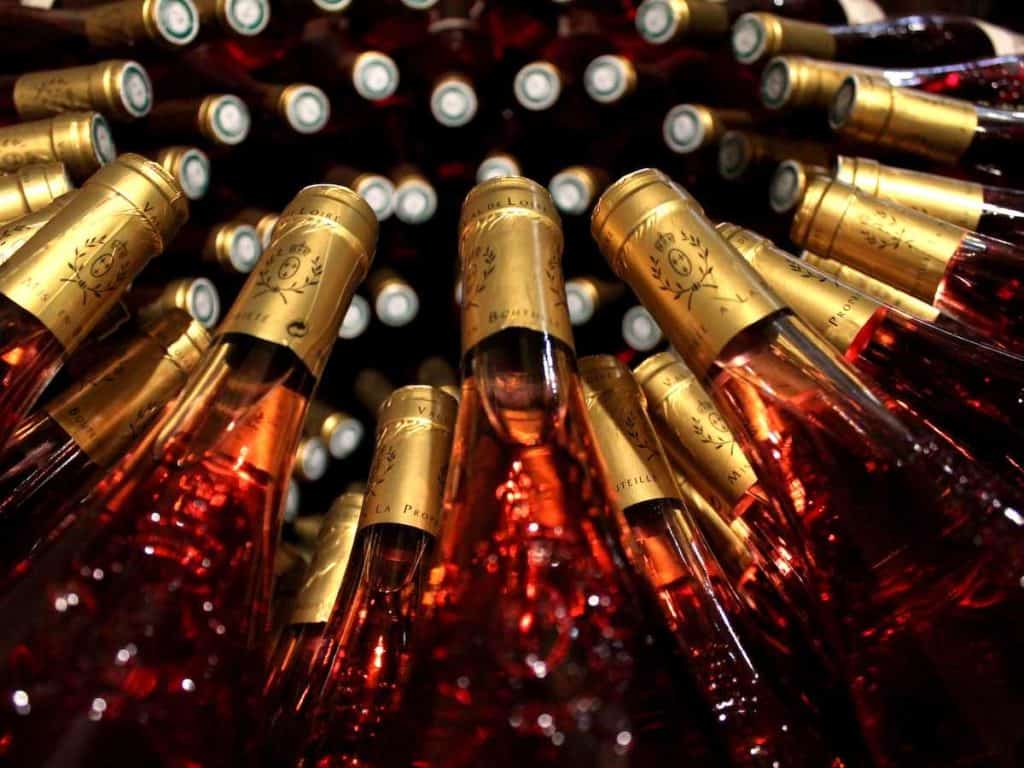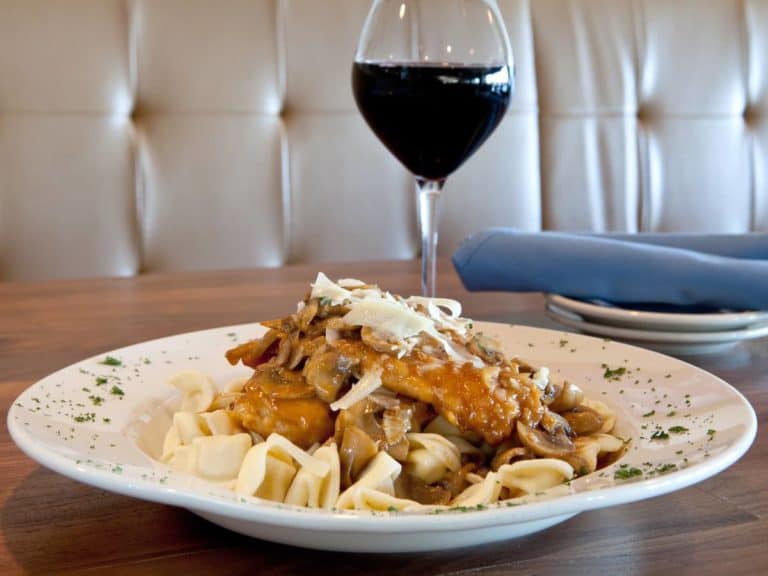Are All Rosé Wines Sweet?
When people think of rosé wine, they often think of a sweet rosé. However, rosé wine is one of the oldest varieties of wine in the world, and there is a huge range of different flavor profiles associated with it.
In general, rose wines run the gamut of flavor profiles from very dry to very sweet, with most rosé wines leaning towards slightly dry and acidic with fruity notes. Rosé wine has a flavor usually balanced between dry and sweet, making it a good pairing for many foods and spices.
There’s a lot of confusion about the flavor of rosé since a very different kind of rosé evolved in America than the kind that originated in central Europe. Keep reading to learn more about the different sweetness levels involved in rosé.

Rosé Wine Tends to Be Dry
Even though there is a preconception that rosé wine is sweet, most rosé wines lean towards a semi-dry flavor. The profile of rosé changes from vintage to vintage, with rosé wines spanning the gamut from very dry French rosé varieties to sweet white zinfandel. However, many rosé wines feature strawberry notes and other fruity flavors.
What Grapes Are Used in Rosé Wine?
Rosé wines are made of almost every grape variety you can think of, including white and red grapes. Rosé doesn’t refer to the grapes used in making the wine.
Instead, rosé refers to the processing method used to create the wine’s unique pink coloring. Rosé wines made of red grape varieties are known as “blush” wines because the red grape skins give the wine a subtle blush of pink coloring.
Types of Rosé Wines
Sweet grocery store rosé may be the rosé that many people think of first when they think of this wine type. However, there are many different kinds of rosé to choose from if you’re interested in seeing what this wine has to offer. (Source: Halleck Vineyards)
Sweet Rosé Wines
Sweet rosé wines are the rosé that most Americans are familiar with, since one of the most famous varieties of rosé wine in America is Sutter Home’s white zinfandel. Like white zinfandel, sweet rosé wines have more sugars than drier rosé types. White zinfandel is associated with sweet wines, but dry zinfandel varieties also exist.
Here are a few of the other sweet rosé varieties you should try:
- White Merlot: White Merlot is a rosé wine created from Merlot grapes. White Merlot is a relatively recent wine variety and wasn’t invented until the 1990s as a direct competitor with white zinfandel. White Merlot has a flavor profile with strong notes of berries, cherry, and honey.
- Pink Moscato: Pink Moscato is often included in the rosé wine category even though it isn’t created by normal rosé production methods. Instead, Pink Moscato is created by mixing a small amount of red wine with sweet white wine made from Moscato grapes. Pink Moscato is considered a dessert wine.
- Garnarcha Rosado: Garnarcha rosado is a rosé made from Garnacha grapes. This rosé is a Spanish version of Grenache, but tends to have sweeter fruity notes of grapefruit, green apple, and stone fruits. This variety’s low volume of tannins gives it a mellow, smooth flavor. (Source: Wilhelm Vineyards)
These rosé wines are a good choice for wine drinkers who prefer their wines on the sweeter side, and are generally categorized as American-style rosés.
Semi-Dry and Off-Dry Rosé Wines
Most of the rosé varieties in the world will fall on the semi-dry part of the flavor spectrum when it comes to sweetness. Within this part of the sweetness spectrum, there is great diversity in flavor due to the additional flavor notes added and the way the grapes are processed.
These are the most popular semi-dry and off-dry rosé wines you should try:
- Montepulciano: Montepulciano is a grape varietal that makes a rosé with relatively strong acidity and a mellow, complex flavor. Rosé wines made from Montepulciano tend to be dark, with cherry coloring and flavors. Montepulciano wines are spiced and have notes of orange peel, cinnamon, and clove.
- Sparkling Rosé/Rosé Champagne: Unlike varieties of rosé where the wine is made by soaking red grape skins in the wine for a certain amount of time during fermentation, Rosé Champagne is made by blending white and red wines.
- Sangiovese: Sangiovese grapes are the most popular grape in Italy, and with good reason. However, these grapes aren’t often used to make rosé wines, making a Sangiovese rosé a relatively rare treat. Sangiovese features a heady mix of berry flavors with warm spices like allspice, clove, and cumin. (Source: Wine Folly)
Semi-dry and off-dry rosé wines can vary wildly in flavor, so it’s a good idea to do a few tastings to get a feel for the flavor profiles you prefer. Tasting these wines alongside each other helps highlight their differences.

Dry Rosé Wines
Rosé may not be associated with dry wine since so many rosé varieties popular in the West are sweet rosé or blended blush wines. Still, most traditional rosé wines range from semi-dry to very dry if you look at the whole market and not just American rosé.
Here are some of the most prominent varieties of dry rosé that you’ll find on the market:
- Grenache: Grenache is another darker-colored rosé with a vibrant ruby coloring. Grenache rosé has both berry and floral notes with a hint of citrus. Grenache may also contain notes of allspice. It’s recommended to serve Grenache rosé cold to get the best out of its refreshing flavor profile.
- Provence: Provence rosé wines have a crisp, refreshing flavor perfect for lounging around on hot summer days. Provence rosé has an uncomplicated flavor and a pleasing pale pink color. Provence rosé has a sharper, lighter flavor than New World rosé styles like zinfandel.
- Tempranillo: Tempranillo is a dry rosé with savory and earthy undertones that set it apart from other rosé varieties. Tempranillo is also a heavier rosé, meaning it pairs well with rich foods such as seafood and roasted meats. Despite its dry flavor profile, tempranillo is still full of soft, fruity notes and aromas.
- Syrah: If you’re looking for a heavy, almost meaty rosé, you should consider Syrah. This rosé variety has an oily mouthfeel and exudes savory flavor notes such as black pepper, white pepper, and cured meat. Syrah also contains flavors of bitter lime and cherry. Syrah is popular with seafood dishes like paella and shrimp scampi.
- Cabernet Sauvignon: If you’re looking for a rosé with a more acidic profile than Cabernet, look no further than Cabernet Sauvignon. The rosé wines made from Cabernet Sauvignon taste more mild and delicate than the bold-flavored red wines made from the same variety.
- Tavel: Tavel rosé is a unique rosé since these grapes are used exclusively for rosé wine. Tavel is considered a useful wine for pairing with food since it is full-bodied and can hold up to most cuisines. Tavel has a translucent salmon or ruby pink coloring. Tavel contains flavor notes of berries, stone fruits, and almonds.
- Mourvèdre: Unlike rosé wines that have a pink coloring, Mourvèdre is closer to a peach shade, with aromas of raspberry and rose petals. The strawberries-and-cream flavor of this rosé is counterbalanced by a moderate acidic punch that helps cut any sweetness in the wine.
- Pinot Noir: Even though Pinot Noir is associated with dark, dry red wines, this grape variety is also used for creating rosé wines too. Pinot Noir rosé has a fruit-forward flavor palate and strong acidity, which gives this wine a hint of sweetness even though it’s classified as a dry vintage.
As you can see, most of the rosé wines you’ll encounter on the market aren’t very sweet at all. Some even contain distinctly savory notes. If you prefer white wines or wines on the dry side, you can still find rosé varieties that you’ll enjoy.
Pairing Food Flavors with Rosé Wine
The biggest advantage of rosé wine coming in so many different flavor profiles (not just sweet) is that it is one of the best wines for versatile food and wine pairings. While many red and white wines are favored for specific dishes, rosé wine contains elements of both styles. As a result, it’s able to pair well with foods on either end of the spectrum.
Here are a few of the reasons why rosé wine pairs so well with so many different kinds of food:
- Balanced flavor profile: Not too sweet, not too dry, not too mellow, not too acidic. Rosé is almost a cross-section of all other wine styles put together. The smooth blend of flavors in rosé keep it from clashing against stronger flavor profiles in food.
- Fruity and floral aromas: The fruity and floral aromas associated with rosé help stimulate the appetite and activate the senses, encouraging people to enjoy their food more.
- Moderate acidity: The acidity in rosé helps deepen the flavor in foods and can off-set foods being served that don’t have a lot of acidity themselves. Bringing an acidic taste to the palate makes other flavors in the food stand out more clearly.
For gatherings, rosé is especially popular with brunch dishes, such as eggs, and it’s also a common afternoon wine for casual get-togethers. Rosé is often paired with light appetizers as an aperitif before larger, richer meals.
Related Article: Fruits That Pair Best With Rosé Wines
Why Do People Think of Rosé as Sweet?
To figure out why most people regard rosé as a sweet wine even though most rosés aren’t that sweet, you have to look at rosé’s history.
Even though this is one of the oldest styles of wine made, rosé didn’t gain popularity in American markets until the 1970s, when Sutton Home wineries accidentally created the first white zinfandel varietal by leaving too much sugar in the wine during the fermentation process.
This phenomenon is known as stuck fermentation, or when the process of wine fermentation is stalled mid-process.
The first creation of the white zinfandel might be a happy accident, but no one could have anticipated how popular this wine style would become. By the late eighties, white zinfandel was easily the best-selling wine in America.
Throughout the 1970s-1990s, white zinfandel remained the most common rosé wine that most Americans were exposed to. The popularity of sweet rosé in America even led to this new style of wine being labeled as New World Rosé. This helped differentiate it from Old World/European rosé wines, which put a greater emphasis on spice inclusion and drier varietals.

Is White Zinfandel a “Bad” Rosé?
You might hear some wine buffs snub white zinfandel as a style, and there’s a few somewhat unfair reasons for this.
These are the big reasons why white zinfandel has a mixed reputation among sommeliers and wine enthusiasts:
- It is not high-quality. Compared to the centuries-old legacy grapevines used to make wines in central Europe, the grapes used for mass-produced white zinfandel are mediocre at best. Since many people who drink white zinfandel aren’t drinking it for a nuanced flavor profile, not as much effort is put into making this sweet rosé complex.
- It’s a “house style” wine. White zinfandel is made to be as consistent in flavor as possible, and doesn’t really take any culinary risks compared to other wine styles. If wine was beer, white zinfandel would be the Bud Light of beer. For drinkers who are more interested in a curated taste experience, white zinfandel doesn’t have much to offer.
- It’s inexpensive. For some serious wine drinkers, cheap wine automatically equates to a subpar wine. For those people who view owning and drinking vintage wines as a status symbol, white zinfandel is seen as a wine for people who don’t appreciate wine as an art form.
Though these might sound like major drawbacks for white zinfandel, at the end of the day it’s a sweet rosé style immensely popular in North America and has been for decades. Whether or not it’s a “good” rosé or not compared to traditional European rosés, there is certainly a market for it. The best wine is the type you like drinking, no matter what style it is.
Rosé Comes in a Range of Flavors
If your only exposure to rosé has come from poor-quality New World sweet zinfandels or sugary-sweet blended wines like Arbor Mist, you might have the idea that rosé is a sweet wine only suited for brunch and desserts.
Hopefully thanks to this guide, you’ll have an idea of just how much variety there is in the rosé world and what to try next!
Related Article: Is Rose Wine a Mix Of Red And White?





